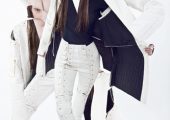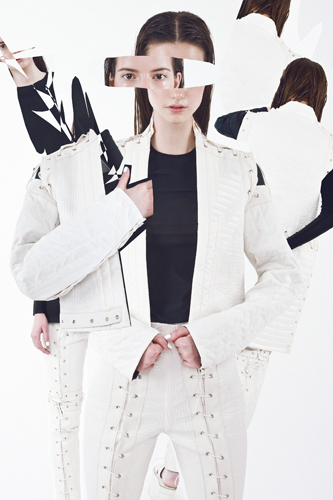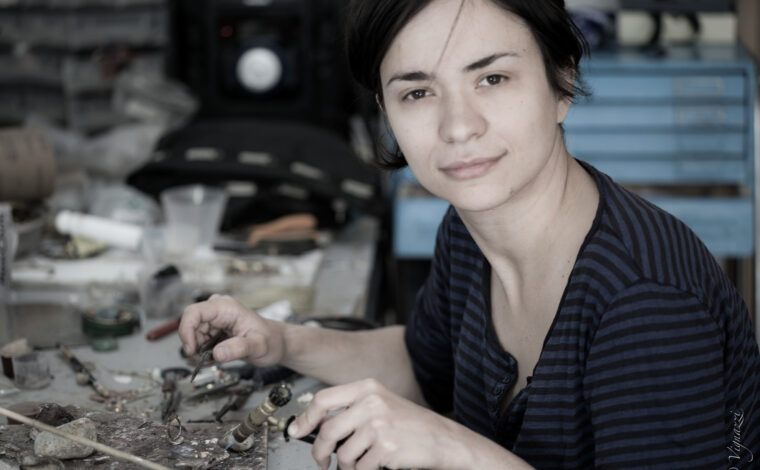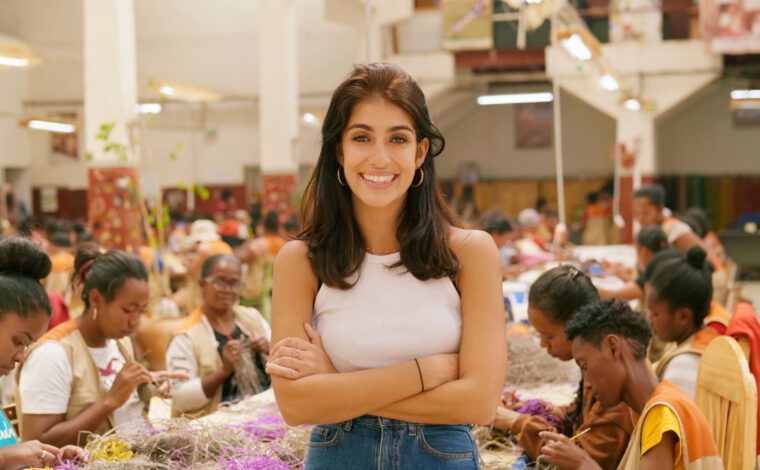di Guan Lin Tan
Ignacia Zordan, fashion designer Cile/Italiana a Parigi, ha presentato la sua seconda collezione per l’autunno-inverno 2015. Si è laureata all’università Universidad Finis Terrae in Cile e ha fatto esperienza allo Studio Bercot a Parigi. Ignacia ha lavorato da Rick Owens, Paco Rabanne e Manish Arora prima di lanciare il suo brand. Il suo lavoro è uno studio sulla femminilità e sul concetto di azzeramento dei generi:
gender (ˈdʒɛndə):
Definitions
noun (informal) the state of being male, female, or neuter
Word Origin C14: from Old French gendre, from Latin genus kind
Collins English Dictionary
– Gallery Pictures Credits:
Photo by Rod, Photo assistant Nicolas Silva, Styling INI, Styling assistant Vera, Shoes Isabel Felmer, Hair & Make up Josefina Riquelme, Featuring Dasha (Welovemodels).
Ignacia, hai detto spesso che la moda per te è Arte, un forma di espressione. Quando è stata la prima volta in cui ti sei trovata ad essere identificata attraverso la moda?
È stato al liceo quando ho scoperto la prima volta l’impatto che la nostra immagine ha sugli altri. Il modo in cui ti vesti e appari è un mezzo molto potente quando si tratta di come le persone ti percepiscono e ha un’enorme influenza sulla vita di tutti i giorni.
Come creativa, pensi che il tuo punto di arrivo sia essere diventata una fashion designer o questa è soltanto una tappa?
Più che una fashion designer, mi considero come qualcuno che ha una sensibilità creativa. Molti sono i mezzi espressivi che uso e che amo…dalla musica alla pittura e penso che comunque non sia il “mezzo” a definire un artista. Per ora ho deciso di dedicarmi alla moda.
Nella tua prima collezione hai “cancellato” la figura femminile proponendo una silhouette assolutamente “boyish”. Il look genderless è continuato fino alla tua ultima collezione Fireland. Che ne pensi della relazione fra femminilità e mascolinità?
Femminilità e mascolinità sono due concetti definiti dalla società. Si riferiscono a quanto le persone si vedano come donne o uomini. Mi piace giocare con questi codici mostrando come una donna possa essere mascolina senza intaccare minimamente il fatto di essere donna. È tutto un gioco in cui si spostano più in la i confini per far capire alle persone e farle riflettere alla soggettività delle definizioni sociali e spingerli a cercare il proprio modo di definirsi e chi vogliono essere.
Cosa ha creato e definito la tua prospettiva sul concetto di genere?
Sin da quando ero giovane ho percepito e sentito questa differenza “sociale” fra uomini e donne e ho sempre sentito il bisogno di dimostrare che come ragazza potevo essere come un ragazzo. Ho capito allora che in realtà non esiste davvero una differenza…siamo uguali, le differenti qualità che possiamo avere si riferiscono e sono figlie più delle nostre storie più che al nostro genere.
Per rispondere alla tua domanda allora…la mia prospettiva sul genere è stata modellata e “definita” dalle mie esperienze. Ho avuto la fortuna di crescere circondata da persone che avevano differenti tendenze e che quindi era possibile essere una donna e vedersi ad esempio in modo maschile o essere un uomo e sentirsi e vedersi come una donna. Ciò che siamo è indipendente dal nostro sesso per come è definito biologicamente. Mi rifiuto di accettare che ci sia una differenza fra i generi. I ruoli legati al genere e gli stereotipi sono determinati dalla società e non sono innati. Per me nasciamo tutti come “pagine bianche”, le attitudini e le qualità e le abilità che sviluppiamo hanno davvero poco a che fare con l’essere una donna o un uomo.
L’industria della moda continua a produrre nuovi brand e nuovi designer ogni giorno, qual’è il tuo “posto” in questo mondo?
Siccome non ho uno scopo commerciale per la moda, sto cercando di trovare e sviluppare dei sistemi alternativi all’industria attuale che di sicuro è piena e saturata da marchi famosi. Le persone hanno bisogno di vestirsi e voglio entrare in contatto e “sintonizzarmi” con persone che hanno un punto di vista simile al mio. Voglio vestire persone con cui condivido gli stessi valori e che sono sensibili e in risonanza con il mio universo…è piuttosto difficile se devo essere sincera, mi sento sempre in un mondo al confine fra arte e la moda perché per me non è solo qualcosa che ha che fare con la funzione di un abito o sul fatto di sentirsi belli. C’è una riflessione dietro, ognuno ha un proprio modo di percepire la realtà espressa attraverso piccoli dettagli. Così potrei dire che sto costruendo un modo nuovo di essere in questo mondo del fashion e allo stesso tempo di non esserci fino in fondo.
Il tuo brand è al contempo un progetto di arte e moda, vivi a Parigi…hai intenzione di puntare ad entrare nel calendario della fashion week parigina? E se si, pensi che questo possa in qualche modo “diluire” la parte artistica del tuo marchio?
Ho già presentato la mia prima collezione a Parigi. Di sicuro essere in una capitale della moda come Parigi e poter mostrare la mia collezione è importantissimo perché è una città che è anche una piattaforma incredibile per far vedere il tuo lavoro. Direi che è il contrario…perchè è molto importante mostrare e confrontare il mio lavoro su un piano professionale e direi che non incide minimamente sul processo creativo e sulla parte artistica delle mie creazioni.
Ignacia Zordan, Chilean-Italian fashion designer based in Paris, presented her second collection this Autumn Winter 2015. She graduated from the Universidad Finis Terrae in Chile, and was subsequently trained in Studio Bercot Paris. Ignacia has since been at Rick Owens, Paco Rabanne, and Manish Arora before setting up her eponymous label. She capsizes social constructs of femininity, and flattens gender altogether:
gender (ˈdʒɛndə): Definitions, noun (informal) the state of being male, female, or neuter.
Word Origin C14: from Old French gendre, from Latin genus kind.
Collins English Dictionary
Ignacia, you’ve mentioned before that fashion to you is art – a vehicle for expression. When was the first time you found yourself identifying with fashion?
It was in high school when I first discovered the impact that image has on others. The way you dress and look is a powerful weapon when it comes to [how people perceive you] – it exerts a huge influence on everyday life.
As a creative, does your career culminate at the role of a fashion designer, or is this merely a port of call?
More than a fashion designer, I see myself as someone with a creative sensibility. I’ve been drawn into different ways of expression, such as music or painting, and I don’t want to believe that it is the [medium] which defines the artist. I’ve chosen to invest myself into fashion design for now.
In your debut collection you’ve deleted the female figure and proposed a boyish silhouette. The genderless look followed through to your current season, Fireland. What do you think is the relationship between femininity and masculinity?
Femininity and masculinity are two concepts defined by society. [They] refer to the degree to which persons see themselves as women or men. I like to play with these codes showing how a woman can be masculine without being less of a woman. It ́s about pushing boundaries to make people think about the subjectivity of social definitions and look for their own statements to define who they want to be.
What has shaped your perspective on gender?
Since I was young I sensed this social difference between men and women. I always felt I had to prove myself as a girl – I could be the same as a boy. I realized then that there is no such a thing as difference. We are equal, the different qualities we might have applies more to our personal histories than gender.
My perspective on gender has been shaped by my own experiences. I had the chance in life to be surrounded by people with different sexual tendencies – therefore able to observe how it is possible for one to be female and see herself as masculine, or male and see himself as feminine.
What we are are independent from our biological sex. I refuse to agree there is a difference between genders. Gender roles and stereotypes are all determined by society but not innate. In my eyes we are all born as blank pages, the attitudes and abilities we develop have little to do with being woman or man.
The fashion industry is swelling with new labels and designers. How do you view your place on this playing field?
As I don’t have a commercial aspiration for fashion, I am trying to find and develop an alternative system to the existing industry – which is for sure saturated and dominated by established brands. People need to dress and I want to synchronize with people that have a similar point of view. I want to dress people whom I share similar values with and are sensible to my universe…Is quite difficult actually, I feel I am in between art and fashion because clothing to me is not only about functionality or looking good. There is a reflection behind – one’s way of perceiving reality expressed through very subtle details. So I could say I am building my way to this playing field while not yet being totally in there.
Given that your eponymous label is a fashion and art project, and your brand is based in Paris, do you intend to break into the Paris Fashion Week schedule? Will doing so dilute the artistic facility of your brand?
I showed my first collection in Paris already. Showing in a “fashion capital” is really important for a label since it is the right platform to get people to see your work. I don’t believe this would go against the artistic side of the brand. On the contrary, it is an enriching experience to show and compare my work on a professional scale. It doesn’t affect at all the creative process nor the brand’s statement.







No Comment